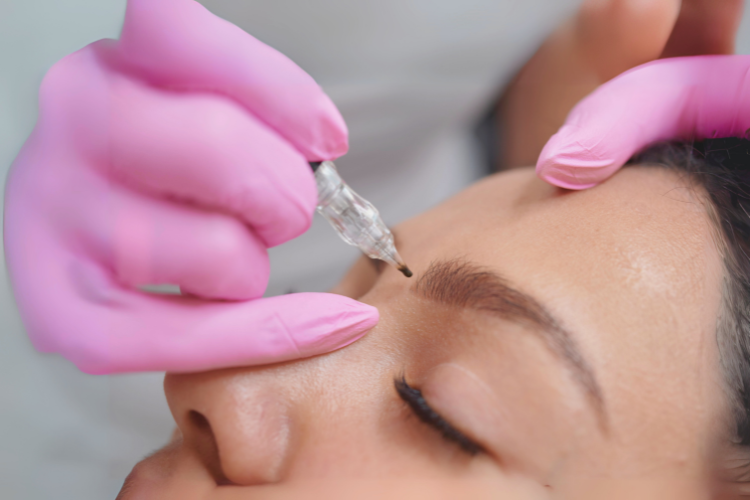We’ve all heard the expression that your eyebrows are meant to be siblings, not twins. It’s almost impossible to make sure they’re perfectly symmetrical when you fill them in by hand. But what if there was a way to wake up with perfectly even and full brows every morning?
Well, there is! If you’re tired of doing your eyebrows day after day with different results each time, microblading may be just the thing for you. Below, we’ll explain exactly what microblading is, how long the results last, what the healing process looks like, and more.
What Is Microblading?
Microblading is a cosmetic tattoo technique that uses tiny needles to deposit ink into your skin. The size of the needles allows for thin, hair-like strokes to blend in with your natural eyebrow hairs. These lines can fill in gaps and/or correct the shape of your brows.
Microblading is great for those who have conditions that affect hair growth like alopecia. It’s also helpful for those whose eyebrows are thinning with age, need a little definition, or were overplucked during the ultra-thin eyebrows era of the 90s.
While cosmetic tattoos are often used to create feminine results, microblading for men can also help accentuate masculine brows, if that’s what you’re looking for.
You can choose ink that’s the same color as your brows for a subtle and natural fill-in, or if you have light eyebrows, you can choose a shade or two darker to make them stand out better. You can also choose a more flattering eyebrow shape for your face than your natural growth pattern allows.
Does Microblading Hurt?
Just like any tattoo, microblading can be painful or uncomfortable for some. The smaller needles make it less painful than a regular tattoo, but more painful than hair removal practices like plucking and waxing.
However, you can always discuss using numbing creams and painkillers with your esthetician or dermatologist. The skin on your face is also a sensitive area, so it will require some extra care and healing time after your session (more on that in the next section).
Microblading Healing Stages
It can take up to 30 days for your skin to heal fully after microblading. When the tattoo is fresh, you may experience some redness and irritation, especially if you have sensitive skin.
The tattoo itself may look too dark or blocky, but don’t freak out. As it heals and the inflammation around it goes down, it will fade into a more natural look.
After a few days, the top layer of skin will begin to scab and flake off. The tattoo may still look too dark, but it will begin to fade as this first layer is shed. You may experience some itchiness as well. Be gentle with your eyebrows during this phase to avoid disrupting the healing process and ruining your results.
Around a week later, your skin should stop flaking and the pigment will begin to fade. After two weeks, the tattoo should be more subtle—the individual hairs should be more defined instead of being too thick. By the end of the 30 days, you should be all healed up with perfectly natural looking eyebrows.
If you have any concerns or questions, always reach out to your esthetician and schedule a follow-up appointment.
How Long Does Microblading Last?
Microblading isn’t permanent. Depending on your skin type and skin care routine, the results of microblading last 1-3 years before you need to make another appointment. You can think of it more like a temporary eyebrow tattoo.
Those with oily skin will need more frequent touch-ups. For longer lasting results, be gentle to the area while your skin is healing and reduce sun exposure as much as possible.
Avoid using skincare products directly on your eyebrows. Let water run over your brows for a gentle rinse until they’ve healed. Acidic products can affect the pigment.
Smoking and even vaping can have a negative effect on healing, so it’s recommended to avoid it until your results are fully healed. We also recommend using a gentle cleanser and sunscreen after the 30-day mark.
How Much Does Microblading Cost?
Microblading can cost anywhere from $100 to $1,200 per session, depending on your location and provider.
You may be able to find something on the lower end of the spectrum if you go to a beauty school and offer to be one of their practice models, but professional results won’t be guaranteed.
While microblading can be expensive, if you choose an experienced eyebrow artist, the results will be long-lasting and well worth it.
What Are the Risks of Microblading?
Like any tattoo, there are risks to depositing ink into your skin. Here are the risks you should be aware of before you book your microblading session:
- Infection – The biggest risk of any body modification is infection. If your artist uses dirty tools or you fail to take care of your tattoo while it’s still healing, the area could become infected. If you experience persistent pain, redness, swelling, and pus, speak with your provider immediately. Always make sure your eyebrow artist is certified and has good reviews to avoid going to an artist who doesn’t follow safety standards.
- Not healing properly – Like we mentioned before, if you don’t practice proper aftercare with your cosmetic tattoos, it could result in pigment flaking off with your skin and leaving you with patchy results.
- Keloids – If your scars don’t heal properly, you could get a keloid, which is a large knot-like scar. It’s rare for keloids to form on the face, but if you’ve ever gotten a keloid from a piercing or tattoo before, take extra care when considering microblading.
- Granulomas – Not everyone’s body reacts well to tattoos. Granulomas are spots of inflammation around the area that can form at any time from right after the procedure to years down the line. However, they are treatable.
- Not getting your desired results – While this one isn’t a health risk, you’re bound to be upset if you spent hundreds of dollars and waited through the healing process only to end up with disappointing results. That’s why it’s important to be very selective about the artist or provider you choose.
Finding the Right Eyebrow Artist
Asking your own dermatologist for a referral is a good way to find a good eyebrow artist. However, dermatologists don’t practice microblading themselves.
If you don’t have a regular dermatologist to give you some options, we can point you to several talented and licensed eyebrow artists and estheticians near you.
You’re just one microblading appointment away from the eyebrows of your dreams!



